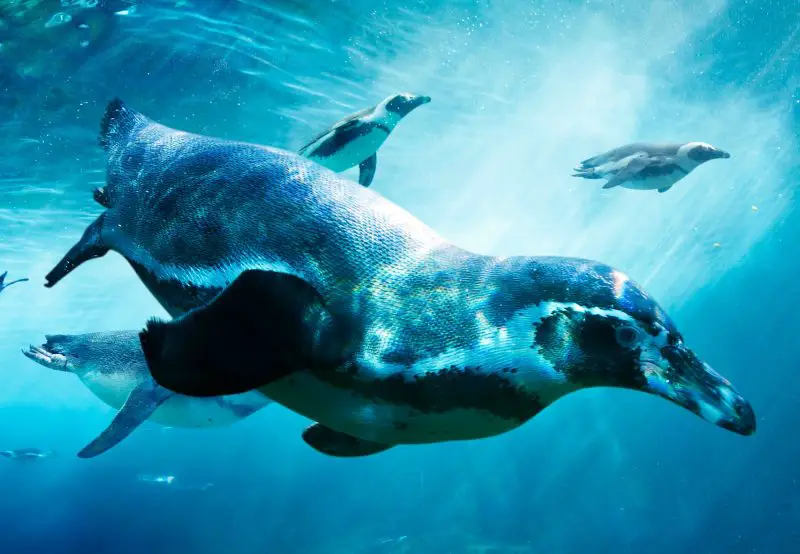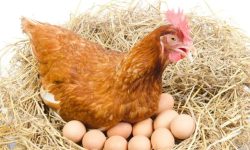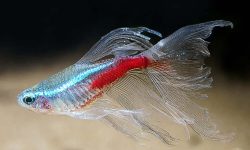Penguins are a marvel of avian evolution. Unlike their airborne relatives, penguins have become supreme divers, thriving in some of the planet’s most inhospitable marine environments. But this conquest of the sea did not happen overnight. It was shaped over millions of years by powerful evolutionary forces. From skeletal reconfiguration to biochemical specialization, penguins underwent a series of remarkable transformations that turned them into nature’s aquatic birds. This article explores, in scientific yet accessible detail, how penguins left the skies behind and became undisputed masters of the sea.

From Wings to Flippers: A Radical Evolutionary Shift
Fossil Evidence and Evolutionary Timeline
Penguins trace their origins to shortly after the Cretaceous–Paleogene mass extinction, around 66 million years ago—a pivotal moment in Earth’s history that cleared ecological space for new adaptive lineages. Among the earliest known penguin fossils is Waimanu, discovered in New Zealand and dated to about 60 million years ago. Though Waimanu retained some primitive traits, it already exhibited clear anatomical adaptations to an aquatic lifestyle: heavy, solid bones that reduced buoyancy, shortened wings transitioning into flipper-like structures, and robust hind limbs positioned for efficient swimming rather than perching or flight.
Over the next several million years, evolutionary pressures in marine environments further shaped the penguin body plan. As penguins foraged increasingly underwater, natural selection favored individuals that could dive deeper, maneuver more precisely, and swim longer distances. The transformation from flight to swimming involved profound skeletal modifications. Wing bones, once structured for lift and aerial control, became flattened, rigid, and paddle-like, ideal for generating thrust in dense water. The loss of aerial flight was not a regression but a trade-off—what penguins sacrificed in air, they gained in water mastery.
Fossil records from Antarctica, South America, and New Zealand reveal a surprising diversity of ancient penguins, including species that stood over 1.5 meters tall. These extinct giants demonstrate that penguins evolved into a wide range of forms and sizes early in their evolutionary history, exploiting niches vacated by extinct marine reptiles and large seabirds. Over time, this diversity narrowed, giving rise to the modern penguin genera we see today—smaller, more specialized, and geographically constrained.
In essence, penguins exemplify an evolutionary trajectory driven not by flight, but by aquatic efficiency—a story written in stone and reshaped by ocean currents, climate shifts, and natural selection.
Skeletal and Muscular Adaptations
Penguins possess a suite of skeletal and muscular adaptations finely tuned for an aquatic lifestyle. Unlike most birds, whose bones are lightweight and hollow to facilitate flight, penguins have unusually dense, solid bones. This increased bone mass acts as natural ballast, counteracting buoyancy and allowing penguins to descend rapidly through the water column. It also enhances hydrodynamic stability, helping them maintain precise control during deep dives and sharp turns.
Their modified wing structure further reflects their evolutionary shift. The bones of the flipper are shortened, flattened, and rigid, forming a streamlined paddle ideal for propulsion. The elbow and wrist joints are nearly fused, allowing limited flexibility but maximizing strength and reducing drag—an arrangement that favors power over versatility.
Muscularly, penguins have retained and repurposed the massive pectoralis muscles, which in flying birds are responsible for powering wingbeats. In penguins, these muscles now drive the forceful, rhythmic strokes of the flippers, producing a movement that closely resembles flight underwater. This “aquatic flight” is not merely metaphorical—penguins literally fly through water using a wing-stroke pattern remarkably similar to airborne birds, but optimized for resistance rather than lift.
Additionally, their supracoracoideus muscle, which in flying birds lifts the wing on the upstroke, plays a supportive role in returning the flipper to position, aiding in propulsion without compromising streamline form. Together, these muscular adaptations grant penguins exceptional thrust, maneuverability, and endurance, allowing them to chase prey with acrobatic precision even in turbulent, high-pressure environments.
A Body Built for the Ocean
Hydrodynamic Form and Streamlined Efficiency
Penguins have evolved a remarkably hydrodynamic body, perfectly suited to life as underwater hunters. Their bodies exhibit a classic fusiform shape—tapered at both ends and widest at the midsection—minimizing drag and reducing turbulence as they glide through water. This torpedo-like silhouette allows for rapid acceleration, tight turns, and sustained swimming with minimal resistance.
Their flippers, once functional wings, now operate as rigid hydrofoils that generate lift-based thrust with each stroke. The wingbeat underwater is not unlike the motion of birds in air, but modified for the denser aquatic medium. By adjusting the angle and cadence of their flipper strokes, penguins can fine-tune speed and direction with exceptional agility. The relatively flat and narrow profile of the flippers also contributes to laminar flow, reducing drag during both propulsion and recovery phases.
Feather structure plays an equally critical role in maintaining hydrodynamic efficiency. Penguin feathers are extremely short, stiff, and densely packed, creating a smooth, waterproof outer layer. Beneath this sleek surface, the plumage traps a thin layer of air, which serves dual functions: it acts as thermal insulation against frigid waters and reduces skin friction, further enhancing glide efficiency. During dives, this air layer compresses with depth, but its presence remains vital in reducing energetic costs and maintaining core body temperature.
Together, these structural and functional traits create a highly specialized morphology. Penguins are not simply swimming birds—they are biological submarines, evolved over millions of years to exploit the ocean’s dynamic three-dimensional space with a precision unmatched among birds.
Thermal Regulation in Extreme Cold
Penguins thrive in some of the coldest environments on Earth by employing an advanced suite of thermal adaptations. Beneath their skin, a thick layer of blubber, composed of energy-dense lipids, acts as a primary insulator. This subcutaneous fat is especially well-developed in deep-diving and polar species such as the Emperor Penguin, where it functions not only as thermal protection but also as an energy reserve during prolonged fasting or extended foraging trips beneath sea ice.
Their plumage adds another critical layer of defense. Penguins have short, overlapping feathers packed in dense arrays that trap air close to the skin. This insulating air layer is further protected by oily secretions from the uropygial gland, which penguins spread over their feathers during preening. The oil provides waterproofing that prevents cold water from penetrating the plumage, significantly reducing convective heat loss during extended periods in icy seas.
At sea, penguins also rely on countercurrent heat exchange systems in their flippers and legs. Warm arterial blood flowing from the body core is positioned adjacent to returning cold venous blood. This close proximity allows heat to transfer internally, keeping extremities from freezing without sacrificing overall body temperature—a strategy seen in many cold-adapted animals.
On land, particularly in Antarctic species, penguins exhibit remarkable behavioral thermoregulation. Emperor Penguins, for example, form tightly packed huddles during polar winters, reducing their exposed surface area and creating a shared microclimate that dramatically lowers heat loss. Individuals continually rotate between the warmer interior and the colder outer edges of the group, distributing warmth evenly across the colony.
These integrated adaptations—anatomical, physiological, and behavioral—allow penguins not merely to survive, but to remain active and reproductively successful in environments where temperatures plunge well below freezing.
Mastering Vision, Buoyancy, and Breath Control
Underwater Vision: Seeing in Two Worlds
Penguins rely on exceptional vision to detect, track, and capture swift, elusive prey beneath the ocean’s surface. Unlike most terrestrial birds, penguins are adapted to see clearly in two vastly different environments—air and water—each with its own refractive challenges. To compensate, penguins possess highly muscular eyes capable of altering the curvature of the lens to adjust focus between mediums, a process known as accommodation. This allows them to maintain visual acuity whether swimming after fish or navigating on land.
The penguin retina is densely packed with rod photoreceptors, which are highly sensitive to low light levels. This adaptation is crucial for foraging in the dim, bluish depths of the ocean, especially during deep dives or in polar regions with extended twilight. Although their eyes also contain cones for color vision, the rod-dominated retina suggests that penguins prioritize brightness and contrast detection over fine color discrimination—particularly useful for spotting the silhouettes or movements of prey against a dappled seascape.
Further enhancing their hunting efficiency, penguins possess an enlarged and highly developed optic tectum—the midbrain region responsible for processing visual motion. This structure allows them to interpret fast, complex movements in real time, enabling them to react with split-second precision as they chase darting fish, squid, or krill. Combined with their streamlined body and powerful flippers, this visual processing capacity transforms penguins into formidable underwater predators.
In essence, penguin vision is a masterclass in evolutionary refinement—balancing the optical demands of life in two worlds, but optimized for the one where their survival depends most: the deep, dynamic, and dimly lit ocean.
Buoyancy Management and Streamlined Control
Penguins face a unique physical challenge as air-breathing animals that hunt in a dense, buoyant medium: water. To dive with speed and precision, they must overcome the natural tendency to float. One of their key anatomical adaptations is dense, solid bones, which contrast sharply with the lightweight, hollow bones of flying birds. This added mass acts as internal ballast, helping to neutralize buoyancy and allowing penguins to descend quickly with minimal effort.
Before initiating a deep dive, penguins engage in pre-dive exhalation, forcefully releasing much of the air from their lungs. This reduces their body’s overall buoyancy, allowing for a smoother and more energy-efficient descent. While this may seem counterintuitive for an air-dependent animal, penguins rely not only on lungs but also on oxygen-rich muscles and blood to sustain them during prolonged submersion, making this strategy effective.
As they ascend, penguins take advantage of another clever adaptation: air trapped beneath their feathers. This compressed air, originally layered for insulation, gradually expands with decreasing depth, generating passive lift. This means penguins can rise toward the surface using far less muscular effort, gliding upward like a balloon under control. This two-phase approach—actively powering downward and passively ascending—maximizes diving efficiency and reduces the energetic cost of returning to the surface.
Together, these adaptations illustrate how penguins manage the physics of underwater locomotion with remarkable precision, fine-tuning buoyancy through a balance of body composition, respiratory control, and feather structure. It’s an elegant solution to the challenges of life as a breath-holding, deep-diving predator.
Oxygen Storage and Deep-Diving Physiology
As breath-hold divers, penguins have evolved a suite of physiological adaptations that allow them to remain submerged for extended periods while pursuing prey in the deep ocean. Among all penguin species, the Emperor Penguin stands out, capable of diving to depths exceeding 500 meters and remaining underwater for over 20 minutes—a feat rivaling that of many marine mammals.
This extraordinary diving ability begins with enhanced oxygen storage. Penguins have exceptionally high blood volume relative to body mass, and their blood carries elevated levels of hemoglobin, the protein responsible for oxygen transport. In addition, their muscle tissue is densely packed with myoglobin, a specialized oxygen-binding protein that serves as a local reservoir. Myoglobin not only provides sustained oxygen supply to working muscles but also allows muscles to function effectively even when blood flow is restricted.
During deep dives, penguins initiate a diving reflex, a physiological response shared with other marine divers. This includes bradycardia—a controlled slowing of the heart rate—which conserves oxygen by reducing overall metabolic demand. Simultaneously, penguins redistribute their blood supply, prioritizing delivery to the brain, heart, and other essential organs, while limiting flow to the digestive system and peripheral tissues.
As oxygen levels drop, their muscles shift to anaerobic metabolism, a temporary energy pathway that does not require oxygen but results in lactate buildup. Remarkably, penguins tolerate this metabolic debt until they return to the surface, where they recover quickly. This ability to manage and extend their oxygen use—both aerobically and anaerobically—is what enables penguins to thrive as deep-diving, pursuit hunters in some of the ocean’s most demanding environments.
Feeding in the Marine World
Tactics for Prey Capture
Penguins employ a combination of anatomical specializations and dynamic hunting strategies to capture fast, agile prey such as fish, squid, and krill. While the specific diet varies by species and region, the fundamental mechanics of prey capture are shaped by a shared set of evolutionary tools.
Their beaks are sharp, pointed, and slightly hooked, ideal for grasping slippery prey with precision. Inside the mouth, penguins possess spiny, backward-facing papillae on the tongue and palate, which function like barbs to trap and hold struggling prey. This ensures that once caught, even wriggling fish or gelatinous squid cannot easily escape.
Underwater, penguins are remarkably agile and responsive. Using their flipper-powered strokes, they achieve burst speeds and execute sharp turns to pursue prey with split-second accuracy. Their eyes are adapted to detect contrast and motion in low-light conditions, allowing them to track individual targets or swarms in murky or twilight waters.
Many penguin species also engage in coordinated hunting, especially when targeting schooling fish. In these scenarios, penguins may surround or herd prey into tight groups, increasing individual capture success while reducing the chance of escape for their quarry. This cooperative behavior is most commonly observed in species like the African Penguin and some crested penguins.
In open water, penguins often utilize a high-speed locomotion behavior known as porpoising—leaping in and out of the water in rapid succession. This technique serves multiple purposes: it allows penguins to breathe without reducing speed, conserve energy through intermittent propulsion, and evade predators like leopard seals by presenting an unpredictable, airborne target.
Together, these tactics reflect the penguin’s evolution into a specialized, high-performance marine predator, one that has traded flight for an even more refined mastery of underwater pursuit.
Energy Management and Metabolic Flexibility
Penguins operate in some of the harshest and most energetically taxing environments on the planet—diving into frigid waters, chasing fast-moving prey, and enduring prolonged periods of fasting during molting and breeding. To survive these demands, they’ve evolved remarkable metabolic flexibility, allowing them to shift between phases of high energy output and deep conservation with impressive efficiency.
During foraging dives, penguins exhibit elevated metabolic rates, rapidly converting energy stores into the muscular power needed for propulsion, thermoregulation, and high-speed prey capture. However, this activity is balanced by an equally important ability to downregulate energy expenditure when necessary. Between dives, and during time on land, they can enter periods of metabolic suppression, reducing oxygen use and conserving calories.
Crucially, penguins are highly efficient at storing fat. After successful feeding bouts—especially during summer, when prey is most abundant—they deposit fat subcutaneously and around vital organs. This energy reserve becomes critical during fasting periods, particularly in breeding and molting seasons, when adults may go weeks without feeding. Emperor Penguins, for example, can lose over 40% of their body mass during a single breeding season as males incubate eggs without leaving their colony.
Moreover, their lipid metabolism is finely tuned. Penguins preferentially burn fat over protein during fasting, preserving lean muscle mass needed for locomotion and thermogenesis. This selective strategy minimizes tissue degradation and ensures survival through extended periods of food scarcity.
Together, these physiological adaptations make penguins models of energy efficiency and endurance, capable of thriving in ecosystems where caloric intake is unpredictable and survival hinges on balancing feast with famine.
Life Between Land and Sea
Reproduction Shaped by Oceanic Demands
Despite being supreme aquatic hunters, penguins are bound to return to land—or sea ice—to reproduce. This terrestrial dependency introduces a complex evolutionary balancing act, as their reproductive timing and success are tightly constrained by the dynamics of the surrounding ocean.
Marine food availability plays a decisive role in shaping penguin breeding cycles. In most species, breeding is synchronized with seasonal peaks in prey abundance. This ensures that the most energetically demanding phase—chick rearing—coincides with periods when fish, krill, and squid are most plentiful near nesting colonies. A mistimed season can spell disaster, especially for species with long chick-rearing periods in unpredictable environments like Antarctica or the sub-Antarctic islands.
The Emperor Penguin, breeding on Antarctic sea ice during the coldest months of winter, represents one of the most extreme examples of this adaptation. Males endure up to two months of fasting while incubating a single egg on their feet, insulated under a fold of abdominal skin called the brood pouch. With females away at sea replenishing energy reserves and foraging over vast distances, the males survive entirely on stored body fat, losing up to 20–25 kilograms in the process. Their ability to thermoregulate, conserve energy, and remain motionless during fierce polar storms is a physiological and behavioral marvel.
In all penguin species, successful reproduction is a race against time—a balance between land-bound parental duties and marine foraging efficiency. This delicate relationship underscores how life on land remains fundamentally shaped by the ocean’s productivity and unpredictability.
Chick Development and Parental Roles
From the moment they hatch, penguin chicks are entirely dependent on their parents for both nourishment and survival. Their primary food source is regurgitated, partially digested prey, delivered directly from the parent’s crop. This mixture—rich in proteins, fats, and lipids—provides the energy and nutrients essential for rapid growth and thermoregulation in often harsh, cold environments.
Penguin species exhibit a division of labor finely tuned to their ecological niche. Typically, one parent remains at the nest to shield the chick from predators and extreme weather, while the other ventures out to forage—sometimes traveling dozens or even hundreds of kilometers to locate dense prey patches. The alternating roles allow for near-continuous care, ensuring the chick receives both thermal protection and regular feeding.
The success of this breeding system hinges on marine foraging efficiency. If prey availability declines—due to warming oceans, shifting currents, or overfishing—adult penguins must travel farther and expend more energy to bring food back. This increases the interval between feedings, leaving chicks vulnerable to starvation and exposure. In species like the Adelie or Chinstrap Penguin, where both parents must leave the chick alone briefly during mid-season foraging, any environmental disruption can dramatically reduce chick survival.
Thus, chick development is more than just a biological process—it is a reflection of the dynamic interface between terrestrial nesting needs and oceanic food productivity. The fine-tuned synchrony between land-based care and sea-based foraging defines reproductive success in all penguin species.
Conclusion
Penguins have not merely adapted to the sea—they have mastered it. Their transformation involved changes in anatomy, behavior, and physiology, demonstrating the power of evolutionary innovation.
From dense bones to oxygen-storing muscles, from hydrodynamic bodies to aquatic vision, penguins are exquisitely suited for marine life.
Understanding how penguins conquered the sea is crucial in the face of climate change and oceanic threats. Their story is not just one of adaptation, but one of resilience, complexity, and evolutionary triumph in the face of environmental extremes.






